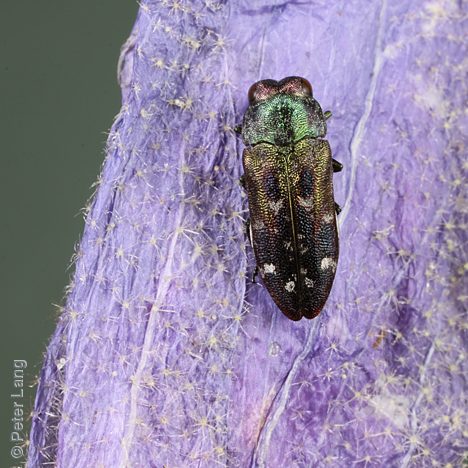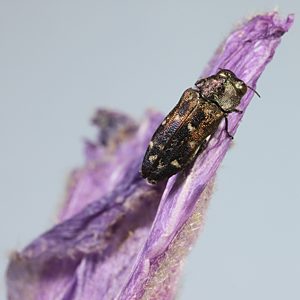













Actual
size¹:
size¹:
6.2 mm
×
2.3 mm
×
2.3 mm














| male | female | |||||
|---|---|---|---|---|---|---|
| L1 | 6.0 | 4.8 – 6.7 | n = 17 | 6.4 | 4.65 – 7.85 | n = 18 |
| L2 | 6.0 | 4.75 – 6.65 | n = 17 | 6.4 | 4.6 – 7.8 | n = 18 |
| W | 2.2 | 1.55 – 2.5 | n = 17 | 2.3 | 1.6 – 2.9 | n = 18 |
| Legend | L1 | length from clypeus/frons to elytral apex (mean, range, sample size) |
| L2 | length from anterior of edge of eyes to elytral apex | |
| W | maximum width with elytra fully closed |
Relatively narrow body shape; head and pronotum with pink, dark green or blue-violet tones; tarsal claws more appendiculate than bifid and often spreading.
This entity occurs with Neospades chrysopygia in western SA, and may merely be a form of that species, or more likely, of N. rugiceps which it more closely resembles in colouration. However the difference in tarsal claws suggest the possibility of it being a separate taxon. It also has similarities to Neospades picta described by Carter 1923a from Brisbane.
| Legend | P.J.Lang collection vouchered records | |
| other private collection or museum specimens, or sightings |
|
|
|
|
|
|
|
|
|
|
|
|
|
||||||||||||||||||||||||||||||||||||||||||||||||
|
|
|
|
|
|
|
|
|
|
|
|
|
||||||||||||||||||||||||||||||||||||||||||||||||
| Jul | Aug | Sep | Oct | Nov | Dec | Jan | Feb | Mar | Apr | May | Jun |
| Legend | live emerged adults, count > median value of 6 per quarter month | |
| live emerged adults, count <= median value of 6 | ||
| live non-emerged adults only, for that quarter month | ||
12 | number of active beetles for that quarter month |
| beetles | sites | SA regions¹ | family | position on host plant | |||
| Hibiscus solanifolius | 14 | 1 | NW | M | |||
| Hibiscus krichauffianus | 13 | 3 | NW, GT | M | |||
| Eremophila scoparia | 2 | 1 | EP | S | |||
| Abutilon sp. | 1 | 1 | GT | M | |||
| Alyogyne pinoniana | 1 | 1 | NW | M | |||
| Dicrastylis sp. | 1 | 1 | NW | L | |||
| Radyera farragei | 1 | 1 | NW | M | |||
| Sida sp. | 1 | 1 | LE | M |
| Legend | beetles | count of beetles collected from, or sighted on, host plant taxon |
| sites | count of major sites (unique 10 km grid cells +/- some distinct approximate localities) | |
| Plant names in green are hyperlinked to a matching host species page with plant photos. | ||
| Code | beetles | % | host plant taxa | |
| M | Malvaceae | 31 | 91% | 6 |
| S | Scrophulariaceae | 2 | 6% | 1 |
| L | Lamiaceae | 1 | 3% | 1 |
| position | beetles | sites | |
| on flower(s) | 27 | 5 | |
| on foliage or non-flowering plant | 2 | 1 | |
| on plant (unspecified) | 5 | 4 |
| colour | beetles | sites | SA regions¹ | |
| blue | 14 | 6 | NW, GT, EP | |
| white | 3 | 1 | GT | |
| yellow | 2 | 1 | GT |
| ¹ Legend | regions | SA State Herbarium regions (map) EA: Eastern, EP: Eyre Peninsula, FR: Flinders Ranges, GT: Gairdner-Torrens, KI: Kangaroo Island, LE: Lake Eyre, MU: Murray, NL: Northern Lofty, NU: Nullarbor, NW: North-Western, SE: South-Eastern, SL: Southern Lofty, YP: Yorke Peninsula |
| size | The ellipse is the correct size when printed, indicative on a desktop screen, and likely to be wrong on a mobile device. |